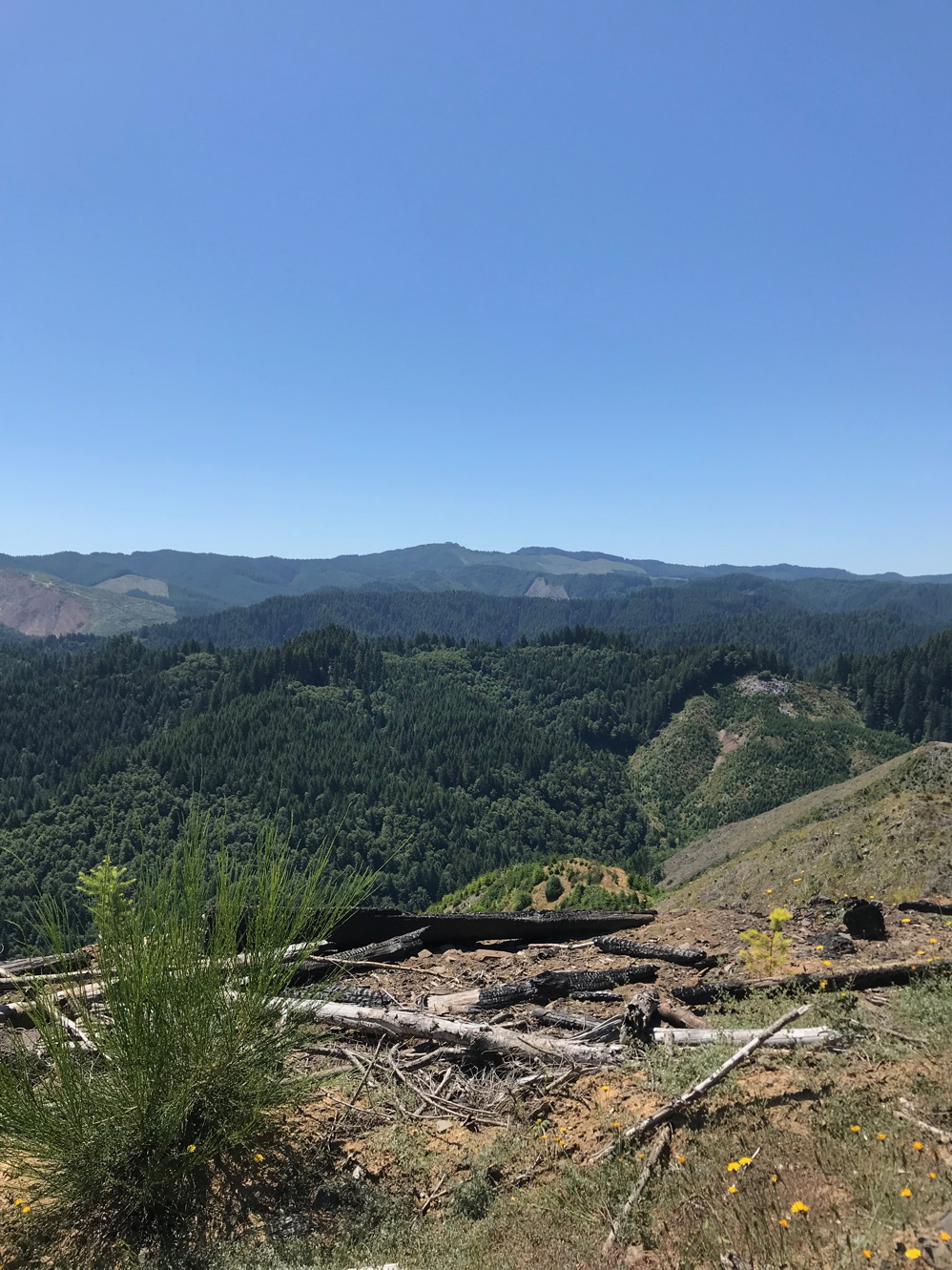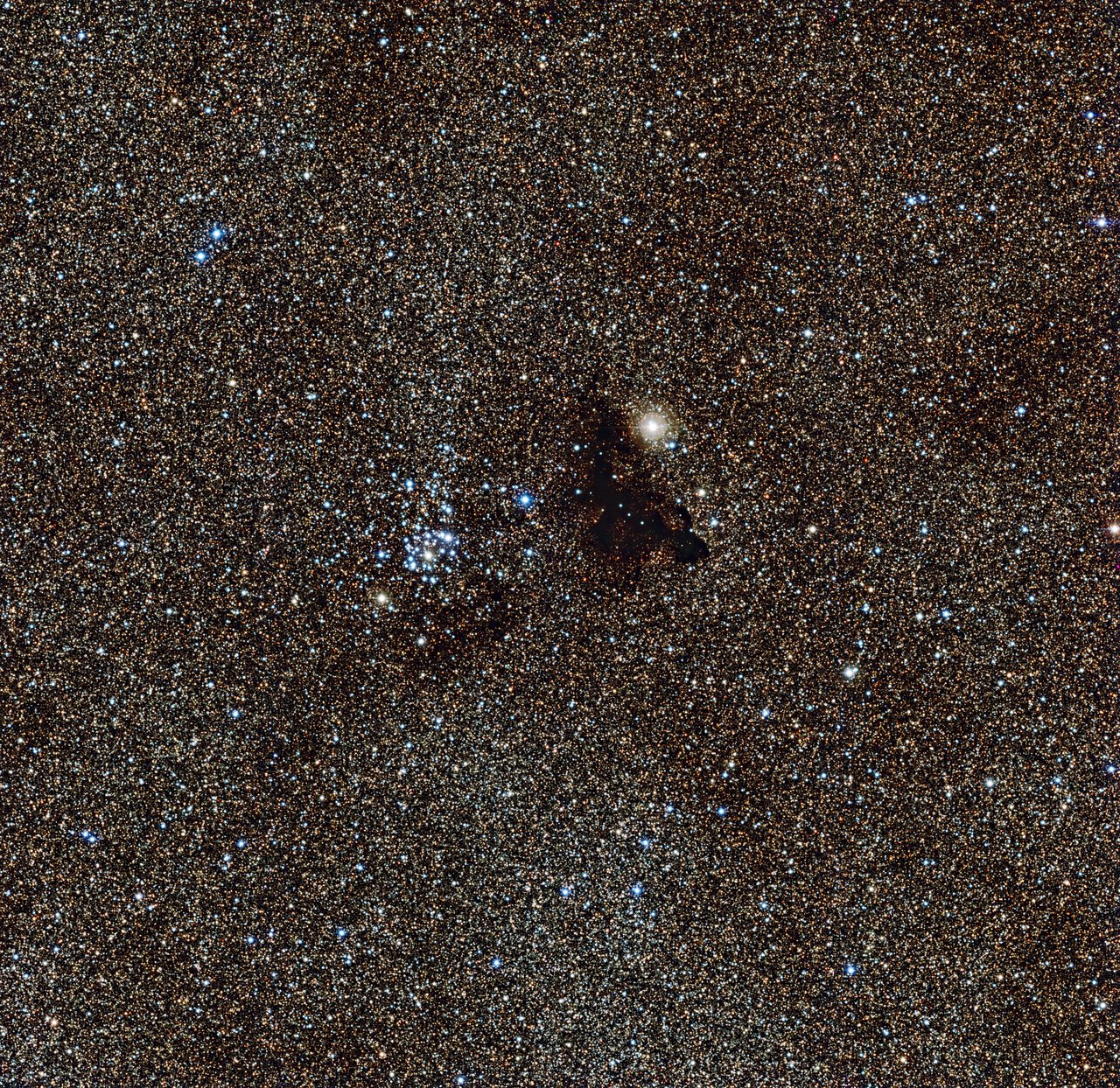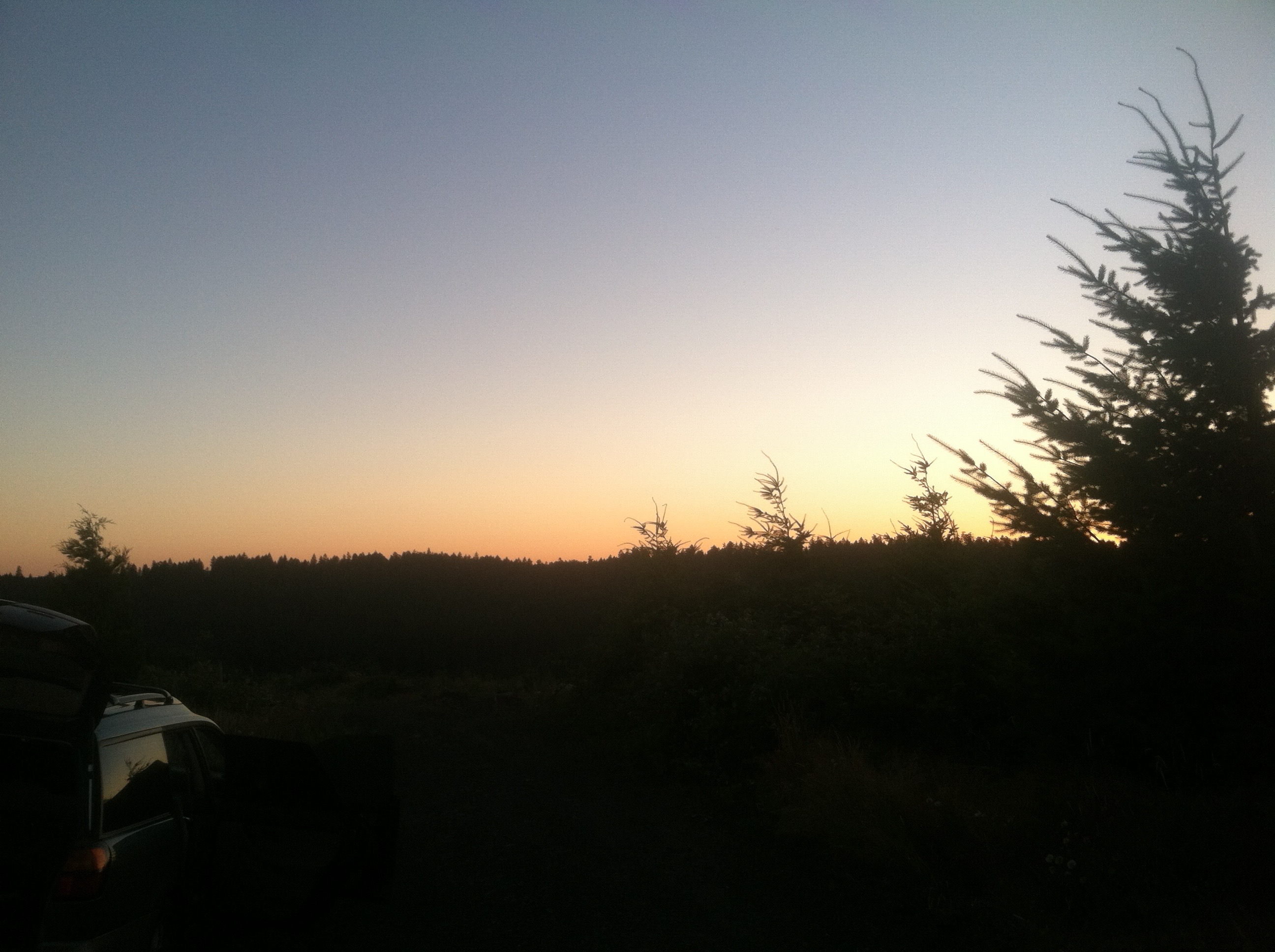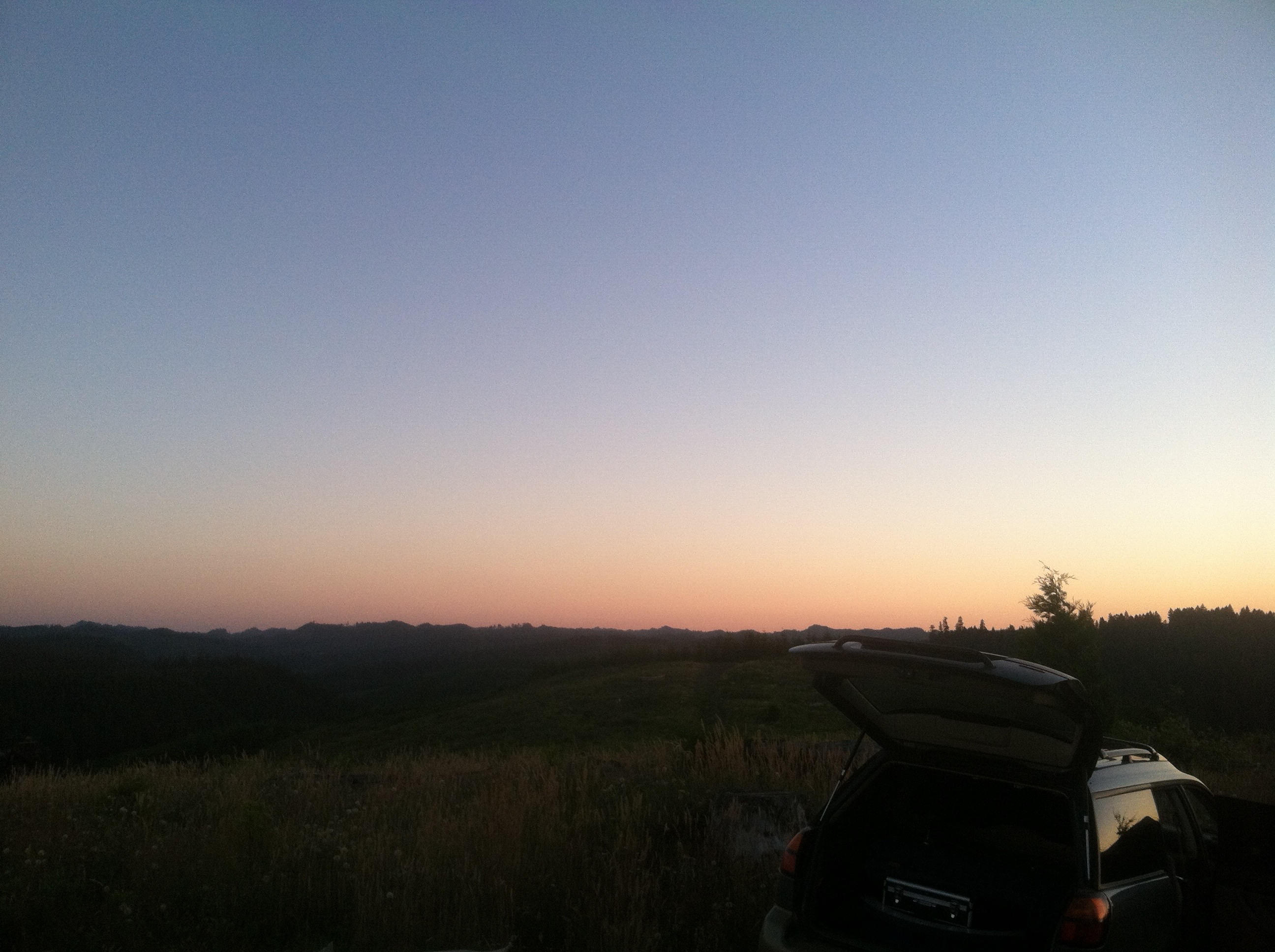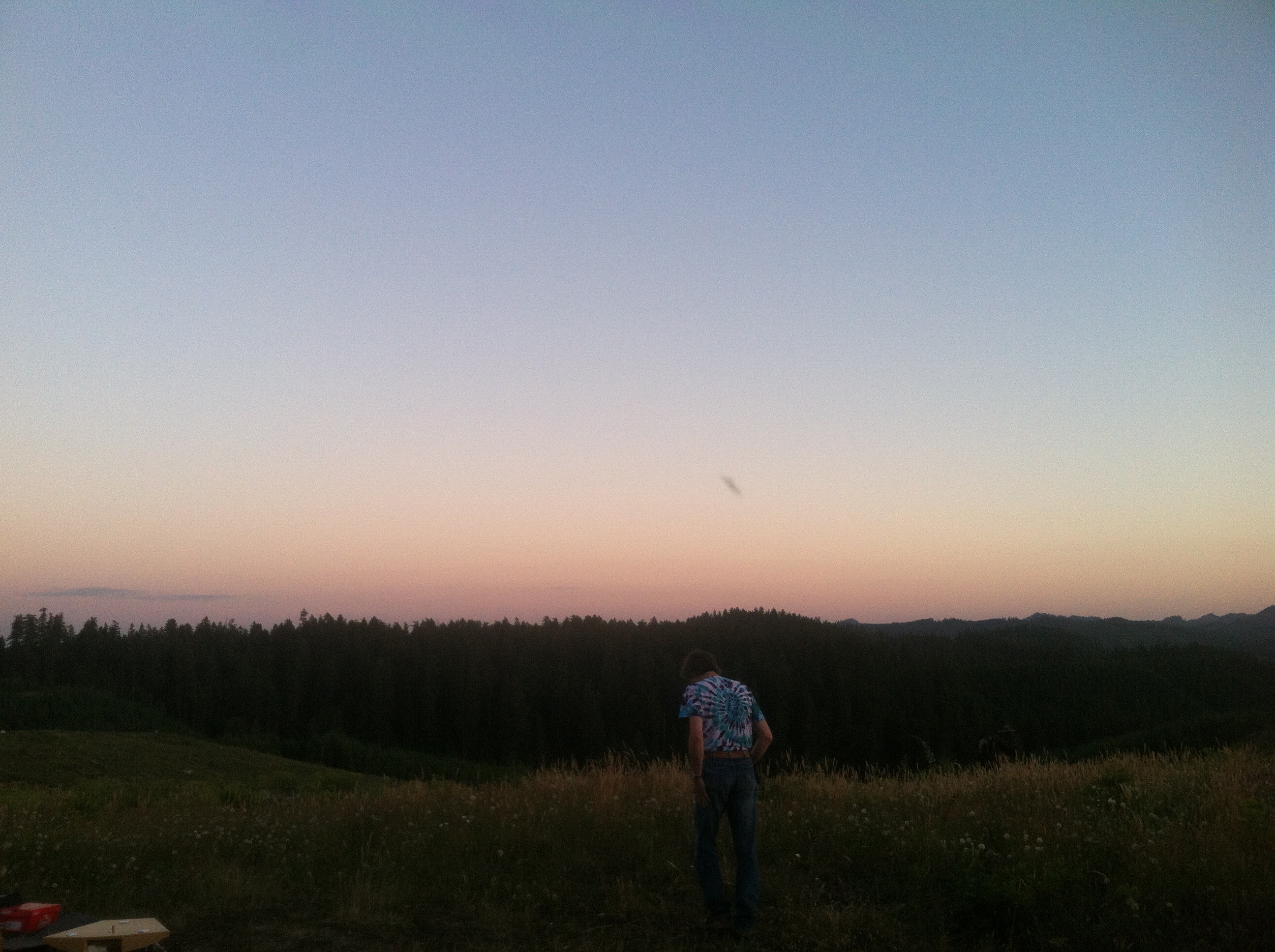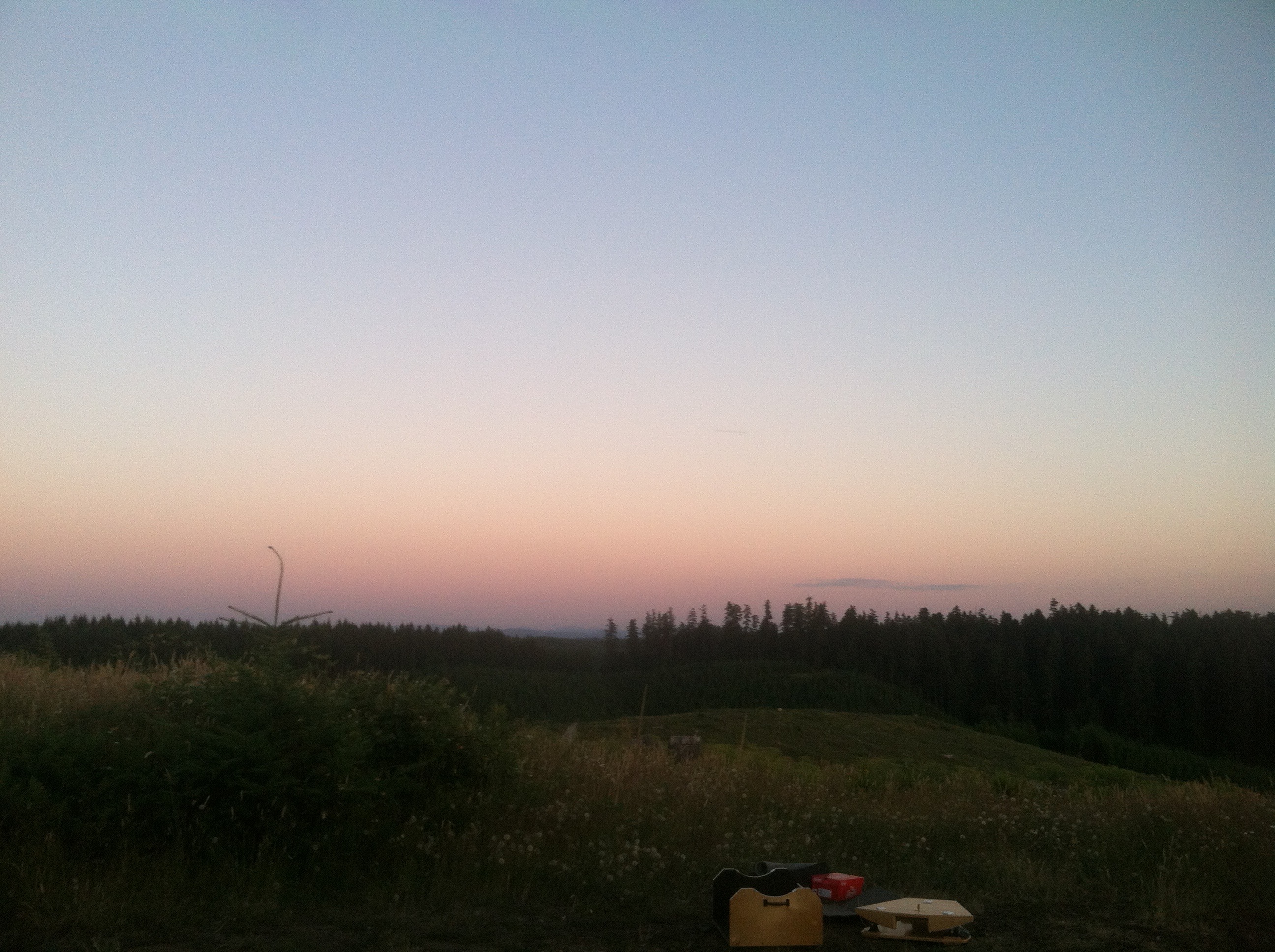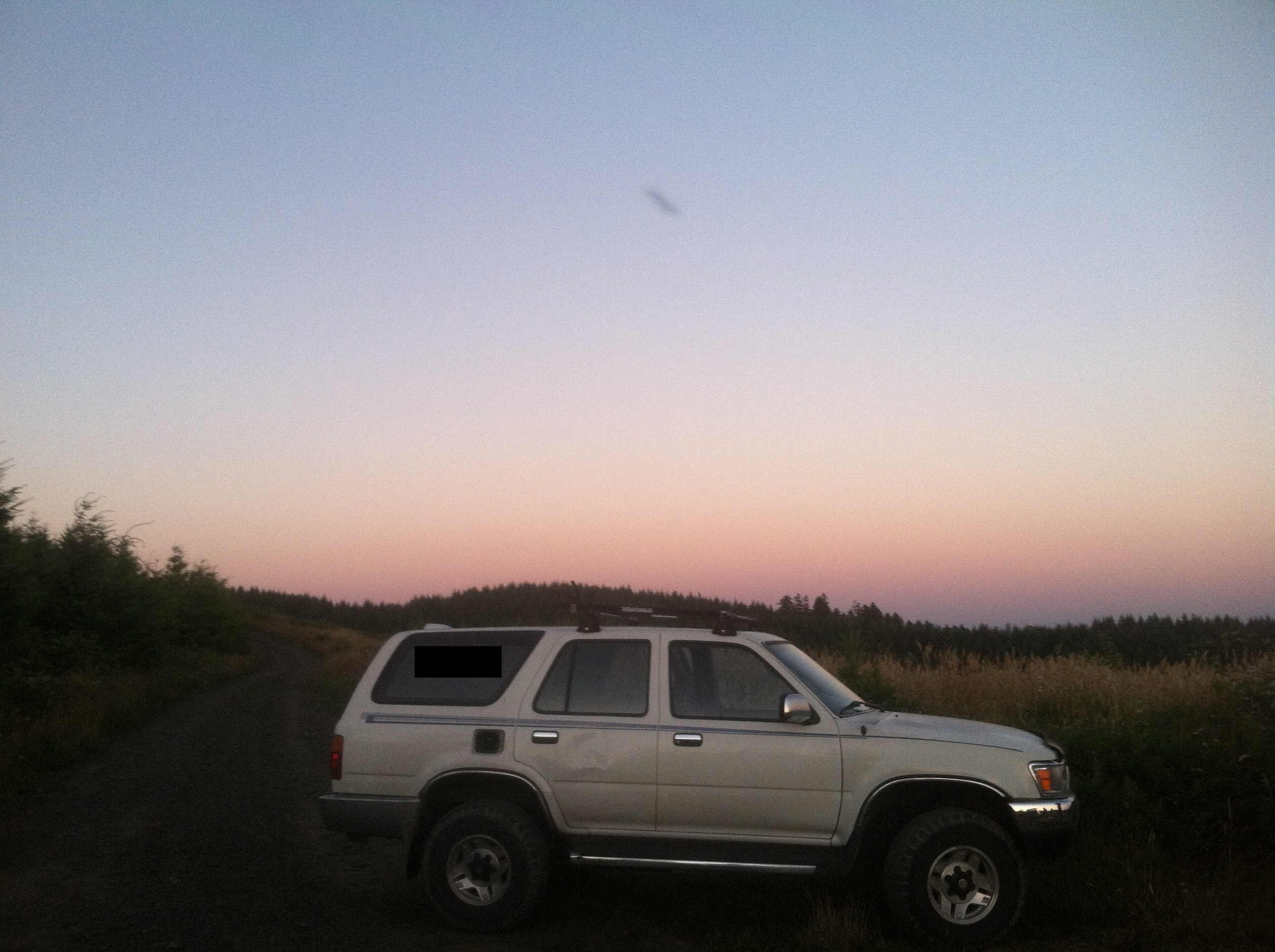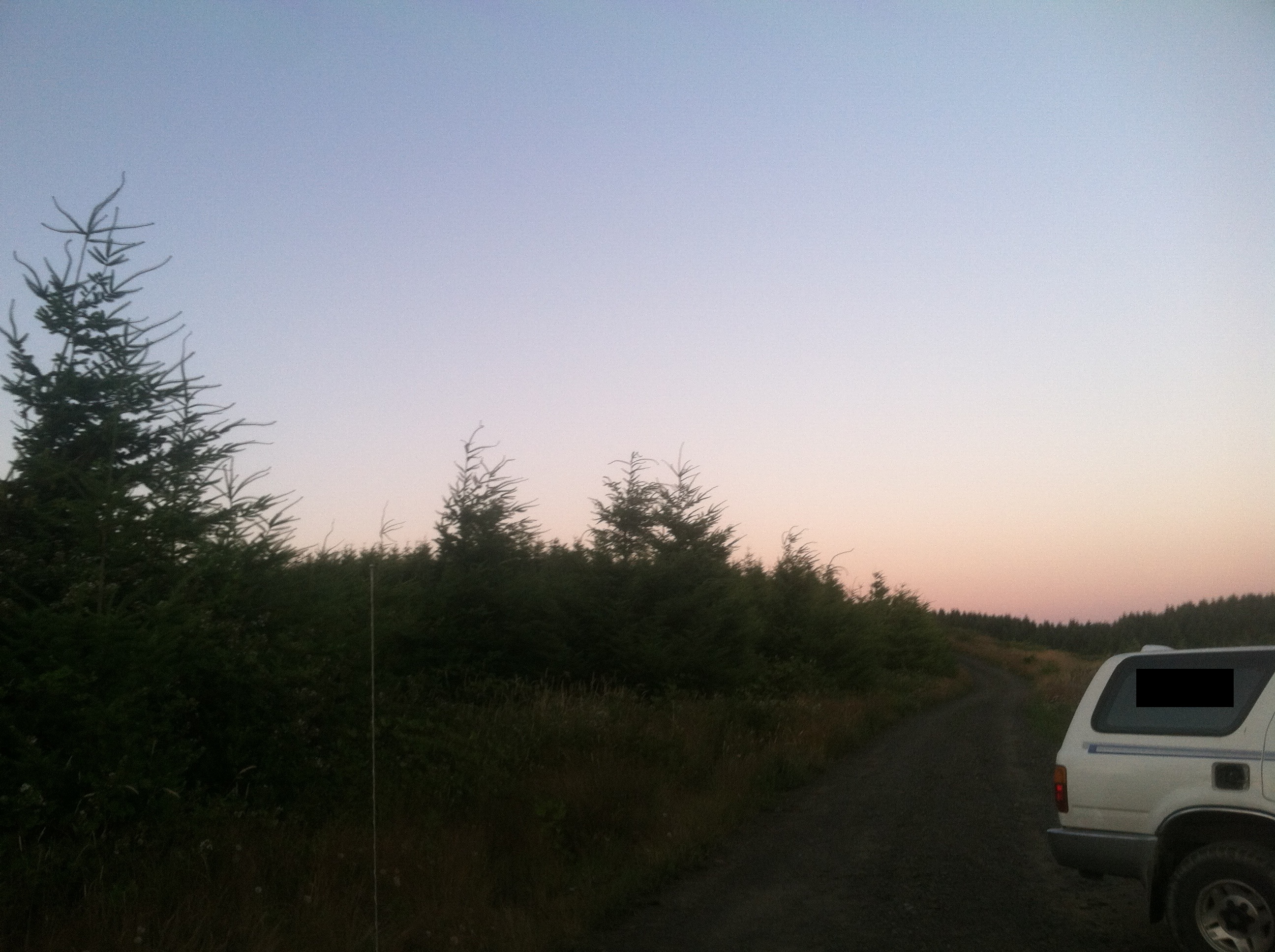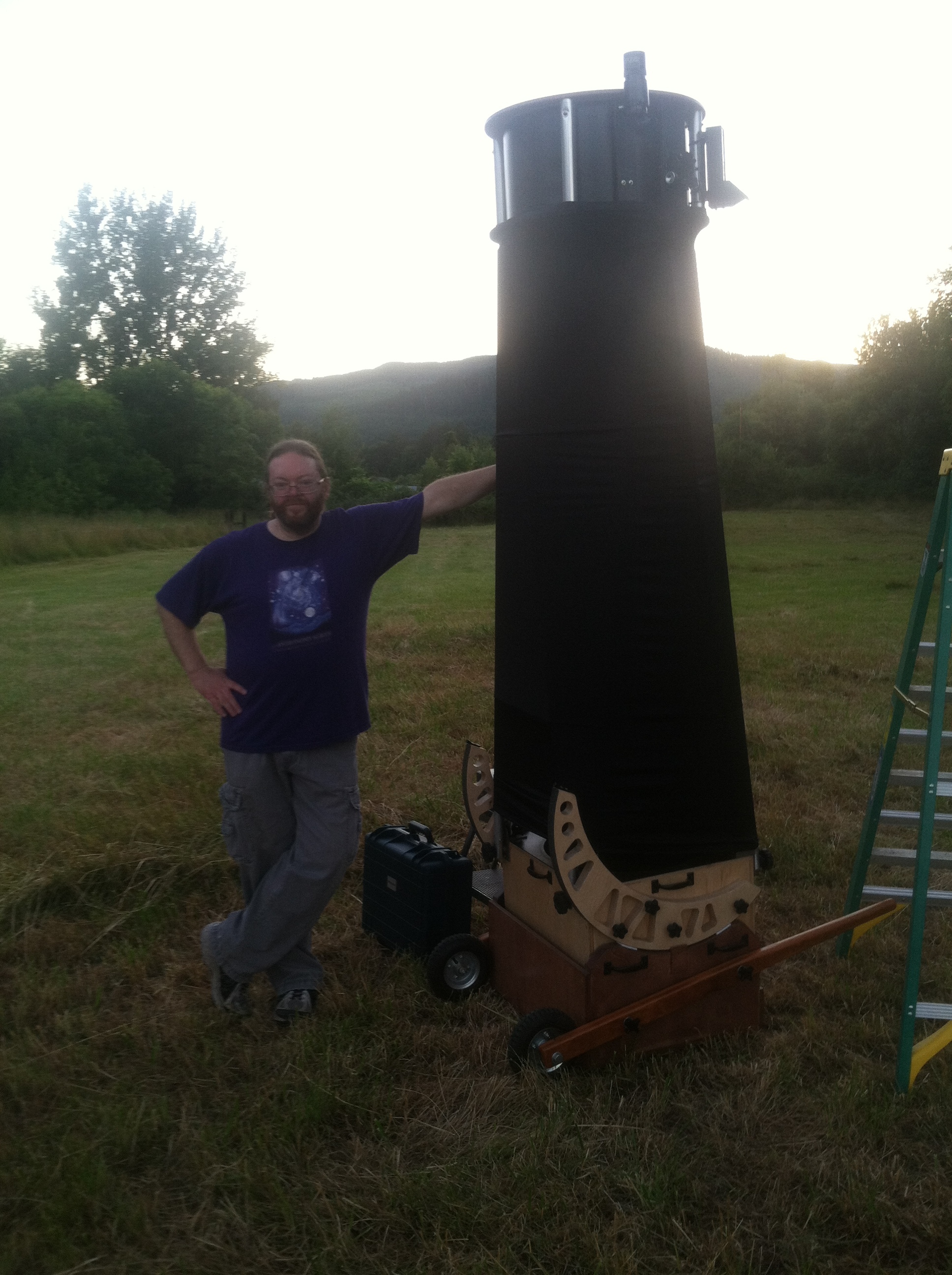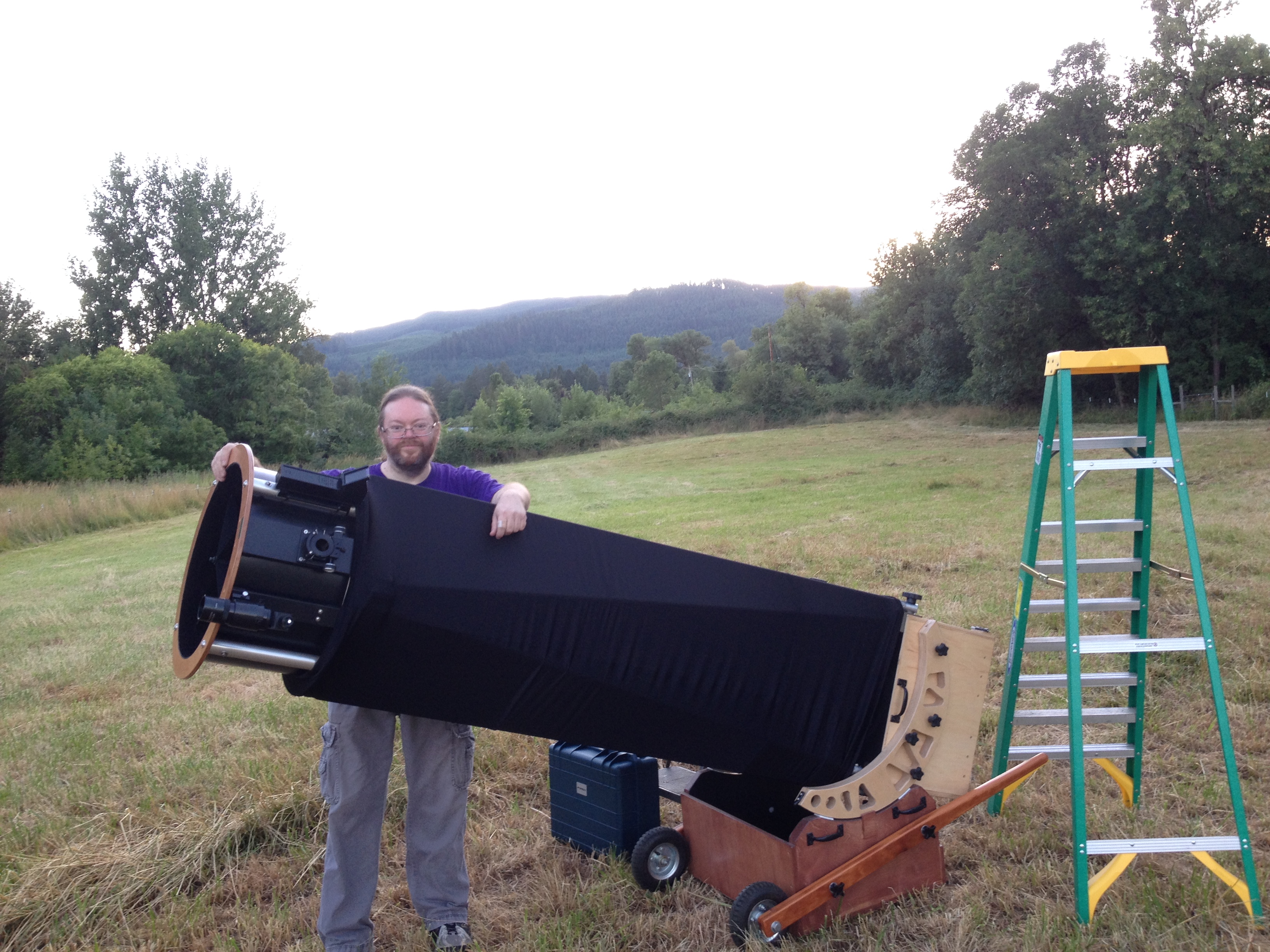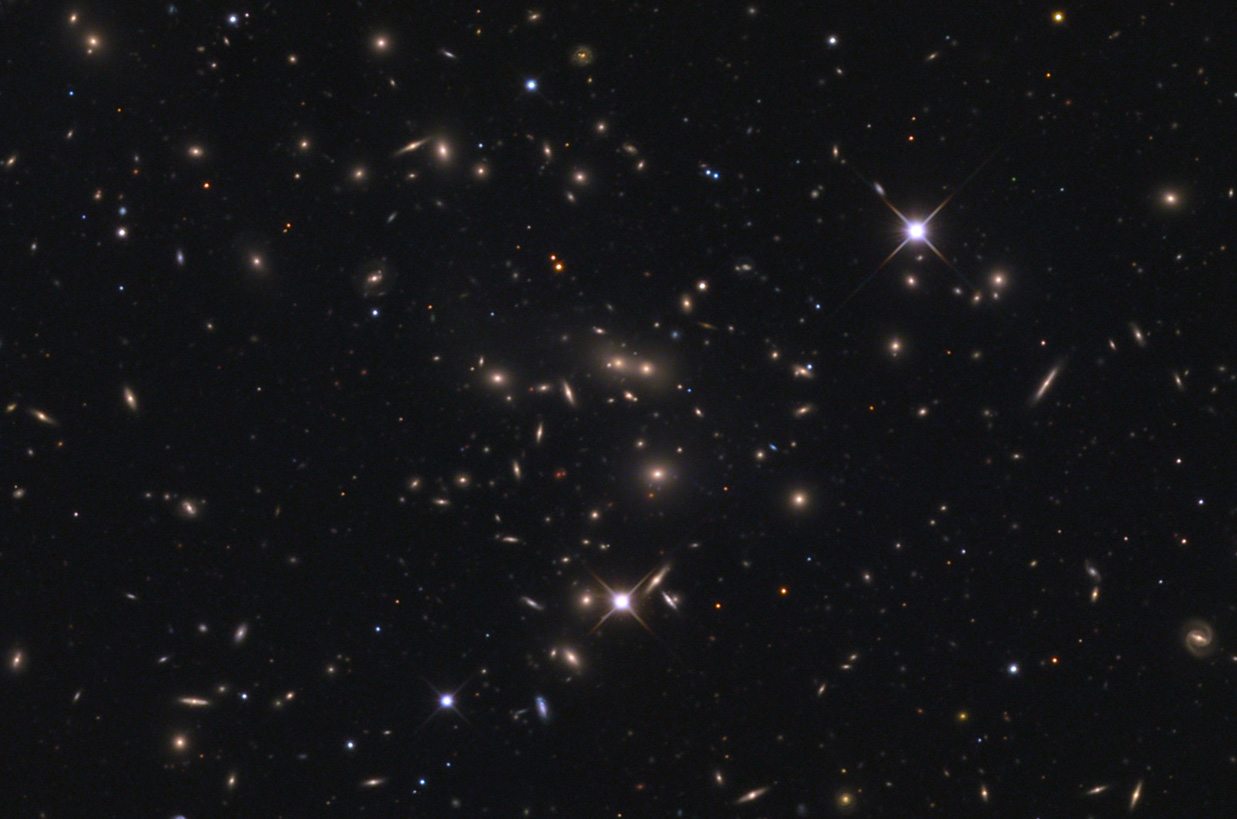The transition to summer observing, with its planetary nebulae and globular star clusters in abundance, accompanied several changes at ground level for me and the others in the EAS Irregulars. Being generally exhausted from work, I had time only to observe on the weekends; with sunsets being so late in the summer, observing couldn’t even really begin until 11 PM, and I needed to be awake for work by 5:30 to monitor the conditions of my digestive tract before spending the day at an injection press. This meant that at best, I got four nights a month to observe. So many targets, so little time.
The bigger transition was one of convenience. The great old Caveman-Mobile, which had served me so well for the last eight years in hauling telescopes up mountains and families cross country, had finally developed a chronic-but-incurable ailment; having put several hundred more dollars into replacing nearly everything on the dear old thing that could be replaced, we could no longer justify another $600 repair. It was time to retire the poor beast from active service while its dignity remained intact.
Enter the new Caveman-Mobile, a 2011 Ford Flex—an odd-looking beast that nonetheless somehow had room for the 20” Obsession and all of its paraphernalia and still drove like a luxury vehicle. Mrs. Caveman and her father tracked the monster down near Seattle and flew up to get it, taking it for a high-speed sojourn on the way home. Although I was somewhat dubious of this vaguely station-wagon-looking thing being an adequate replacement—-it seemed too pristine for the kind of heavy lifting needed to get to our sites of night-sky communion—there was no real turning back.
The Flex’s first excursion to an observing site actually occurred during the day, checking out a site that Dan B had been monitoring for some time. We had been searching for a site closer to town that could serve as a short-night site (i.e. one that we could conveniently use for a couple of hours, as opposed to hauling everything out to Linslaw for a full night’s work), and Dan had found this one—on rural Fisk Road—that appeared to pass muster. It was like a closer, mostly-paved Eagle’s Ridge, an intersection of a couple of gravel roads with a convenient widening to the side of the intersection where several telescopes could be set up. There were a few trees partially blocking the southern view, and the full light-pollution dome of Eugene/Springfield would be mostly visible, but the site seemed adequate for nights when we didn’t want the full drive time to and from Linslaw.
The weekend after our initial recon of the Fisk site, we headed there for a christening of sorts. With (waning gibbous) Moonrise coming shortly after astronomical darkness, we made it a casual evening; Dan and Alesha, Loren and Donna, and Jerry and Kathy and Dan R joined Mrs. Caveman and I for an on-site potluck to kick off the late May-early June Moondark phase. It was also a night for trying out a couple of recently-donated telescopes: a 130mm Celestron something-or-other that wasn’t a dreaded Bird-Jones-type scope, but was actually rather fine optically, and a really old (1976 vintage) 8” Celestron Schmidt-Cassegrain with the classic orange tube and all original accessories. I brought along my own black-tube 8” Celestron—my first telescope—to give it some dark-sky time.
It was a thoroughly enjoyable evening, with no expectations of serious observing to be done, but lots of high-spirited talk and telescope evaluation. (The 130mm Celestron has since been introduced into the EAS telescope-lending library, while the orange-tube classic 8” still needs some adjustments and fine tuning.) We left after Moonrise, with surprisingly strong winds howling up the road and plans to return the next night for somewhat more serious observing.
I. Jerry, Dan, and I arrived at Fisk well before sunset; Dan and I got there first and did some more exploring of the site, including climbing over one of the berms and checking out a large open field (which was slightly overgrown in patches) that lay beyond the accessible road. We’d never be able to haul larger scopes over the berm, but it was certainly a tempting possibility.
Jerry arrived a bit later, bringing with him one of his latest projects: a homemade electric guitar. He and Dan exchanged a few songs (Jerry had an amplifier running off of one of his 12-volt batteries), no doubt annoying some of the neighbors; I had visions of some of the nearby rustics trying to figure out where that rock-n-roll was coming from in the middle of the woods.
Dan B in concert. No Stairway!
The wind howled all night, apparently funneled up the road by the trees. Huddled into a corner of the clearing that was blocked from the brunt of the wind, we still had to deal with its effects, often hanging onto telescopes to prevent them from being buffeted about. The roaring of the wind made my audio recordings a chore to transcribe; in some ways it was fortunate that I only had three sets of notes from the evening. Conditions otherwise weren’t great, either; several intruding waves of cirrus caused temporary havoc as they passed through, and the seeing was particularly poor until after midnight.
In addition to working on the AL Planetary Nebula program, I’ve also undertaken to take notes on all of the 2450 objects that William Herschel catalogued during his spectacular and unequaled career. With the Herschel 400 and Herschel II programs already under by belt, and a number of others beyond those, I had at least 900 of Herschel’s discoveries in my repertoire. What was particularly welcome about the remainder of Herschel’s objects was that there were hundreds in every season; if I was stuck on another program, or didn’t have the motivation for, say, a list of flat galaxies on a given night, there were always more Herschels to dig into.
Tonight’s agenda consisted of both “the remaining 1600” of Herschel’s galaxies, clusters, and nebulae, and several of the planetaries on the Astronomical League’s program list. But I spent the first part of the night (and some time between Herschel objects and waiting for some of the needed planetary nebulae to rise) observing globular clusters, enjoying views of M13, M92, and NGC 6229 in Hercules, along with NGC 5634 in Virgo, M80 in Scorpius, and M71 in Sagitta. When all else is exhausted, globular clusters-—my first and ultimately foremost favorite type of deep-sky object— are a source of unending wonder and cosmic glory.
05/30-31/21
FISK ROAD
SUNSET: 8:47 PM
MOON: 20 days (rose at 12:44 AM; 71% illuminated)
SEEING: 4, 6
TRANSPARENCY: 5, 6
SQM: 21.33
NELM: not checked
WEATHER CONDITIONS: temps to mid-50s; no dew due to strong winds; some cirrus waves throughout the night
OTHERS PRESENT: JO, DB
All observations: 12.5″ f/5 Discovery Dob, 14mm ES 82˚ eyepiece (112x, 0.7˚ TFOV) or 7mm TeleVue Nagler (225x, 0.36˚ TFOV) unless otherwise noted
10:55
NGCs 5468, 5472 (Vir):This is a Herschel object, while I’m waiting for planetaries to rise in Cygnus, Aquila, Lyra, and Draco; this is NGC 5468 in Virgo, seen in very variable transparency and strong wind. The galaxy is extremely diffuse; there’s no core to speak of, although in averted vision there’s a substellar nucleus that pops into view every now and then (or possibly a very tiny core). The galaxy is round, about 2.0’ diameter, very diffuse and poorly defined. It’s unevenly bright; the interior of the glow is kind of irregular; it appears that there may be a bar or something in it that’s just a touch brighter than the rest of it, oriented almost P-F; it’s hard to hold this for certain, but it’s always the same direction. NF the galaxy by 2’ is a threshold (14.5-magnitude) star. The brightest star in the field is only 4.25’ S slightly F the galaxy and is 8.5 magnitude. Due F the galaxy by 5.5’ is a 13th-magnitude star that has just P it by a couple of arcseconds a tiny faint glow (NGC 5472) that comes and goes with the variable transparency. It’s hard to get a fix on it; it may have a stellar nucleus, as there’s a hint of another stellar object there. From the star just F that galaxy, NP by 0.75’ is a 14.5-mag star. S very slightly F the 8.5/9th-magnitude star by 8’ is a 9.5-magnitude star; then S very very slightly P that star by 4.5’ is an 11.5-magnitude star that has a 14th-magnitude star 0.75’ S very slightly P it. From the 11.5-magnitude star P very slightly N by 6.5’ is an 11th-magnitude star.
11:07
NGCs 5427, 5426 (Vir): This is a really fine interacting pair in the back end of Virgo, NGCs 5427 and 5426, with -27 being due N and considerably larger; there’s a very faint (14th magnitude?) star right between the two of them. NGC 5427 is quite diffuse and not really well defined; it does have a distinctly brighter interior. It’s roughly round, with maybe a tiny bit of P-F elongation; this is indeterminate enough that I’m not going to say anything beyond the fact that it’s 1.67’ round. It’s roughly the same size as NGC 5468, actually, but considerably brighter. As with 5468, there is some inner irregularity to the brightness, if not outright mottling; there’s a very, very slightly brighter core that’s also very small; this is obviously a face-on galaxy. I’m actually going to say this is 1.75’ x 1.67’, very slightly elongated P-F. Every so often, there’s a flicker of a tiny, faint nucleus. (Immediately due S of the galaxy, exactly between the two galaxies, is a 14th-magnitude star that distracts from whether either galaxy has a visible nucleus, but I think they both do.) NGC 5426 is elongated N-S and has a brighter core that’s also elongated N-S within a 1.5’ x 0.75’ halo. The outer edges are pretty unevenly defined, but appear better defined to the S. It almost appears as if the two galaxy’s haloes are trailing slightly to the P, as if they’ve had material pulled off of them in that direction, but this is just an impression and I wouldn’t say anything about it with certainty. This would be a stunning pair in the 20”! At moments, with 5427, I get a feeling like the F edge has a little better definition, or a little more brightness, like there’s a subthreshold spiral arm on the F edge. 5426 also has the occasional flash of a nucleus. The core is 18” long (i.e. between 0.25’ and 0.3’). There is dark space between the two galaxies where the star lies, so they’re two distinct and discrete objects. Some very faint stars lie to the S; there’s a 14th-magnitude star S very slightly F 5426 by 7’; S very very slightly F 5426 by 7’ is another 14th-magnitude star. NF the pair, 11’ from 5427, is a 12th-magnitude star. SP 5427 by 12’ is an 11.5-magnitude star that’s the NP of a very thin flat scalene triangle, with a 12.5-magnitude star F somewhat S by 1.75’; from that star S very very slightly F by 1’ is a 13.5-magnitude star. There’s a very flat isosceles triangle F very very slightly S of 5426, actually a diamond, with the NF vertex very faint compared to the others; the point star in the isosceles triangle, the “roof-top” star, is a very close pair.
We took SQM readings about midnight, and were surprised to get 21.33s (on average) between us. The sky didn’t really seem quite that dark, due in large part to the unshielded light dome from the cities taking up most of the eastern half of the sky. The trees to the south weren’t a dealbreaker, at least.
With Cygnus and the higher-declination summer constellations well above the trees to the east now, I stopped by the Veil Nebula, the Dumbbell (which I’d already taken notes on), and the Ring Nebula (which I hadn’t, but I wasn’t willing to take notes on it in less than excellent conditions, as befitting its showpiece status). I also skipped taking notes on NGC 7027 in Cygnus, as it looked somewhat diminished from even my previous observations of it from the Giant City State Park visitor center parking lot. I didn’t want to go home empty-handed on the planetary-nebula front, though, so I revisited an object that I’d recently observed from The Oxbow. It, too, was diminished from its previous apparition, but for reasons unbeknownst to me, I pressed on with the observation.
12:09
NGC 6742 (Abell 50; Dra): After a huge amount of searching (it was a tough starhop from 16 Lyrae), this is the difficult (more difficult than it needed to be anyway) NGC 6742. I had found this previously at the Oxbow under apparently much better conditions, because here it’s a difficult object, really requiring averted vision to pick out at first, and that was not the case at the Oxbow when I saw the first time. It’s about 0.3’ across, round, just on the border between direct and averted vision (depending on the moment-to-moment sky conditions). It’s mostly just above the averted vision threshold, so it is visible in direct, but it’s not easy. It’s just a very round, very faint nebula with no obvious annularity, although the S rim in good moments looks to be a fair bit sharper than the rest. In the moments of much better seeing and transparency that we’re getting through here, the nebula looks substantially bigger; it might be 0.5’. There’s no central star, but it does have a faint star F slightly N of it by 0.75’; that star really interferes with the nebula, and is 13.5 magnitude. Also distracting from the nebula is the 8.5-magnitude star SP it by 3.5’; that star is the N end of a small zigzag of fainter stars; this zigzag is about 3.67’ long and has its second-brightest star (which is 11th magnitude) at the S end. There are a number of brightish stars in the field but the 8.5 to the SP is the brightest. N of the nebula by 9’ is the S end of another asterism of somewhat brighter stars, including a couple in the 9th/10th-magnitude range. With the UHC, the nebula is substantially “better” but pretty small, more like 0.3’ again (how does that work?). It’s significantly brighter now, a solidly direct-vision object. There’s still no annularity, but the S rim definitely seems a little brighter than the rest; it almost seems like the brighter part of the rim lies slightly inside the nebula and there’s some fringe around the S edge. The O-III filter really brings out the nebula! There’s a dramatic difference between the view in the two filters: now, the nebula’s substantially brighter again than in the UHC, which I didn’t expect based on the previous work I’ve done on the AL planetaries. The impression that the S end of the rim is brighter isn’t seen in this filter. Again, the nebula is distinctly round, and still 0.3’ diameter. The seeing’s gone to crap again, but I’ll throw in the 7mm Nagler anyway. Seeing is terrible at this magnification, but the nebula still pops right into view. I’m constantly amazed at how much just increasing the magnification is better than just adding a filter to the 14mm. With the 7mm, I’m still not getting a central star, but the nebula’s yet again much brighter. Adding the O-III makes the nebula almost unviewable in combination with the 7mm. Back to the UHC: it’s at least observable with this filter in the 7mm. The S rim still looks slightly more obvious and brighter than the rest; it’s obviously a UHC feature, and not merely a figment of my imagination. This is not a bad little nebula with the right combo; the 7mm and the UHC work pretty well.
Several times during the observation, a curiously warm (almost hot) breeze blew through, wiping out the seeing, drowning out my voice on my notes, and feeling as if—in Dan B’s words—we had “waded into someone’s pee spot in a swimming pool.”
About halfway through my notes on NGC 6742, Dan witnessed a brilliant fireball traveling west from Scorpius. As so often happens (to most of us!) during an observing session, Jerry and I were looking in the opposite sides of the sky, missing the meteor entirely.
The Moon crested the horizon, washing out the Milky Way entirely, completing the job the Eugene/Springfield light-pollution dome had started. We packed up our scopes, unsure of the long-term viability of the site due to the persistent winds, biding our time until weekend nights, Moonless hours, and clear skies coincided again.
II. The next weekend provided a better opportunity for observing, at least on the eastern side of the Valley (i.e. the Eagle’s Rest amphitheater, the only one of our Eagle’s sites that I was willing to drive to). Oddly, only Robert was willing to join me for observing; Jerry had his Friday book club, and Dan and Loren also had other plans. On this particular night, having some extra comrades would’ve likely made a big difference in how the night turned out.
The “amphitheater” was a roadside pullout big enough for perhaps four cars. Until two years ago, it had been hemmed in by trees to the north and west, and by hills to the east; only the southern horizon—the direction of greatest astronomical interest—was clear, overlooking a steep drop into the valley. Now, though, timber and real estate interests had combined to clear-cut the entire northern quadrant, exposing stargazers to the glare of the double city. In place of the trees, some company had installed a large metal gate, for keeping out anyone who might venture past the roadside and into the clearings they had made. Wind frequently blew from the north and through the gate, adding to the nuisance of the light pollution; to remedy this, we often (as tonight) parked near the fence and parallel to the road, using our vehicles as simultaneous windbreaks and light blockers.
My agenda was the same as the previous session: Herschels (mostly galaxies) until target planetaries rose. Most of the Herschels were chosen from Alvin Huey’s guide to the Herschel III list, an unofficial list compiled by Thom Lorenzin from the best of the remaining 1600+ objects not included in the Herschel 400 or Herschel II programs. The sky was a cirrusy mess, but was clearing fairly quickly. And exactly two hours after sunset, I got started with my notetaking.
06/04-05/21
EAGLE’S REST (amphitheatre)
SUNSET: 8:52 PM
MOON: 26 days (rose at 3:22 AM; 20% illuminated)
SEEING: 7
TRANSPARENCY: 6
SQM: 21.26
NELM: not checked
WEATHER CONDITIONS: temps to upper 50s; no dew; mild breeze; cool but not particularly cold; considerable haze at sunset which cleared off by 11:30
OTHERS PRESENT: RA
All observations: 12.5″ f/5 Discovery Dob, 14mm ES 82˚ eyepiece (112x, 0.7˚ TFOV) or 7mm TeleVue Nagler (225x, 0.36˚ TFOV) unless otherwise noted
10:52
NGC 5690 (Vir): While waiting for some of my planetaries to get into a good observing position, we’re looking at some Herschel IIIs in the meantime; this one is NGC 5690 in Virgo, a nice edge-on spiral– not really a flat galaxy because it doesn’t have the right dimensional ratio; it’s about 2.5’ long and 0.67’ wide, elongated due NP-SF (so about 135˚ position angle) and has a very faint (I’m going to say 14.5 magnitude) star on the SF end inside the halo. Observing the galaxy is very difficult because it has a 6.5-magnitude star 3.25’ due P that’s hugely disruptive to the observing. I can’t really get that star outside the field enough to get a good eye on the details here; I can’t tell if the galaxy is mottled and irregularly bright along the length of it, or if it appears that way because it has that threshold star on the end. It’s a pretty fine galaxy, with a pretty well-defined halo. NP the galaxy by 7’ is a 10.5-magnitude star that’s also 5.5’ N slightly P the 6.5-magnitude star. Due SF the galaxy by another 6.5’ is the right-angle vertex of a small triangle; that star is 12th magnitude and has N slightly F it by 1.5’ an 11.5-magnitude star; and then F somewhat S of the right-angle vertex by 2’ is a 13.5-magnitude star. N slightly F the galaxy by another 6.5’ (so almost forming an equilateral triangle with the galaxy and the 10.5-magnitude star) is a 12.5-magnitude star; and F the galaxy by another 7’ is another 12.5-magnitude star that has 0.5’ due P it a 14th-magnitude star.
11:07
NGC 5792 (Lib): NGC 5792 is apparently in Libra, but it’s actually very, very close to the Virgo border; it’s also in the very close vicinity of a distractingly bright star which happens to be P very slightly N of the galaxy by 1.0’. The galaxy is elongated P-F; it’s about 2.0’ x 1.0’, and has a much brighter core region that’s 0.67’ across; every so often there’s a very very brief flash of an extremely faint substellar nucleus. The P-F extensions of the galaxy are very poorly defined and diffuse; they are revealed primarily with averted vision. That core region is pretty bright, though. The star that’s P very slightly N of the galaxy is 9.5 magnitude; there’s another 9.5-magnitude star NF the galaxy by 6’, and that star has a 13.5-magnitude star N very slightly F it by 0.3’, and also has NP it by 1.5’ an 11th-magnitude star. 3.25’ NP the galaxy (so between the galaxy and the 9.5-magnitude star) is a 14th-magnitude star. Also NF the galaxy by 12’ is a 9th-mag star. N slightly F the galaxy by 14’ is a 10th-magnitude star.
As I was observing NGC 5792, I watched a pair of brightish satellites cross the field, both on the exact same trajectory—most likely some of Elon’s Folly.
11:28
NGC 5921 (SerCap): This is our third Herschel III object while we’re waiting for Aquila and the tail of Scorpius to rise; this is NGC 5921 in Serpens, and it is definitely a more interesting galaxy than should be limited to the 14 mm; I tried the 7mm Nagler, but the sky’s just not good enough for it really; I think this one needs a bigger aperture for a good look. It’s in a pretty crowded field; there is an arc of four stars to the south of it, and the galaxy is also bracketed on the P very slightly N and F very slightly S by stars almost equidistant from the galaxy. The galaxy itself is elongated S very very slightly P-N very very slightly F, about 1.75’ x 1.0’. It has a brightish stellar nucleus and a core somewhat brighter than the halo; the core is extended N-S… I don’t want to say that that’s a bar, but (especially in averted vision) there are definitely hints that that’s the case. The halo is reasonably bright and fairly well defined, and that inner region here is fairly complex; this is one that really would deserve a good look with the 20-inch. (They all do, really.) The number of bright stars in the area of the galaxy makes it a little bit harder to get a focus on it as well: here in the 7mm, the brightest of those stars in the galaxy’s immediate vicinity is F very slightly S of the galaxy by 2.75’ and is 10th magnitude; there’s a 12.5-magnitude star the same distance P very very slightly N of the galaxy, and that star also has between it and the galaxy (so about 0.75’ F very very very slightly S of the star) is a 14th-magnitude star. The arc of four S of the galaxy begins due S of the galaxy by 4’ with an 11th-magnitude star; NP that star by 1’ is a 13th-magnitude star; N very very very slightly P that star by 1.67’ is a 12.5-magnitude star; from the 12.5 magnitude star NF by 1.3’ is a 12th-magnitude star; and that 12th-magnitude star is halfway between the previous star and the galaxy, in a perfect line with those. The brightest star in the field is SP the galaxy by 12’ and is 8.5 magnitude.
12:03
NGC 5962 (SerCap): NGC 5962 in Serpens Cauda is a bright little galaxy, and a pretty impressive one as these things go. It’s elongated P very slightly N-F very slightly S (about 100 degrees position angle) and spans 1.5’ x 1.0’. This one is actually more diffuse than most of the ones I’ve looked at tonight, at least halo-wise, and not particularly well-defined, but it does have a fairly small (0.67’) but gradually much brighter core to it and more than just a hint of a stellar nucleus—in averted vision, anyway; it’s not easy to lock it down, as it’s quite faint. The galaxy lies within a pretty attractive starfield, featuring a wide magnitude range. Due N of the galaxy by 3’ is a 12th-magnitude star; there’s a 13th-magnitude star 4.5’ N somewhat F the galaxy and a 10th-magnitude star 13’ NF. 11’ S slightly P the galaxy is a 10.5-magnitude star, and then F slightly S of the galaxy by 16’ is a 7th-magnitude star that’s kind of in the middle of a N-S oriented asterism; this asterism is about 12’ long and vaguely rectangular. 6.25’ P very very slightly N of the galaxy is the more S of a pair; that star is 11.5 magnitude, and it has a 12th-magnitude star almost due N of it by 1’. This is kind of a nice little galaxy to be relegated to the “other” 1600 Herschel objects.
By the time I finished with NGC 5962, Scorpius and Sagittarius had risen into a decent position for working through the remainder of their planetary nebulae. I had seen my target planetaries in those constellations numerous times before—especially the Bug Nebula, one of Scorpius’ showpiece objects—but either had no notes on them, or had notes that were inadequate for the fulfillment of the AL program. Whatever the case, it certainly wasn’t a chore to reobserve them (even though I had to be sitting on the ground at the roadside in order to catch them). The only negative was their extremely low declination; the Bug Nebula was only 6˚ or 7° off the horizon, and the two I had on my list after that were of similar declinations. The lousy seeing that low made the observation a challenge, but there was little chance of being able to do better at a future date; I could always observe them again if the seeing in the deep south was better at Linslaw, where we planned to be on Saturday night. Getting these low objects would enable me to work on the several I had remaining in Cygnus the next night. And I didn’t have much time for the Bug anyway, as it would be disappearing into a bank of trees in less than an hour.
Robert left just before I started taking notes on the Bug.
12:59
NGC 6302 (Sco): This is a difficult look way down low at the Bug Nebula, NGC 6302 in Scorpius, down here in the really poor seeing close to the horizon. The nebula is 1.75’ P-F by not quite 0.67’ N-S. It looks very much like a galaxy with a bright core that’s about the central 0.3’ and what looks like a central star visible as a nucleus in the galaxy analogy. The central star is hard to tweeze out from the rest of the brighter central region. The nebula’s very indistinct on the ends; on the P end it looks as if there’s something of a slightly brighter knot present. There’s no color to the nebulosity. SP the nebula by 10’ is what seems to be—it’s truly hard to tell because of the inevitable atmospheric extinction—a 9th-magnitude star. Due N of the nebula by 4.75’ is the N-most vertex of a scalene triangle composed of 12th-magnitude stars; there’s another SP the first by 1.25’ and a third 2.67’ due P from that first vertex. SF the nebula by 3.25’ is yet another 12th-magnitude star, and P somewhat N of the nebula by 2.5’ is an 11.5-magnitude star. Let’s try the UHC; I don’t know that the 7mm is going to be much use down here with the seeing, but we’re eventually going to try it anyway; I want to start with the UHC. The UHC really brightens the nebula. The supposed “central star” seems to be just a point in the brightness of the nebulosity, because it’s very, very bright now in the filter, and that shouldn’t be the case if it’s merely a star. The filter also helped to define the diffuse ends of the nebula: the P end has much better definition now; it’s much more distinct and tendril-like, while the F side is a little more diffuse and doesn’t really come to a distinct “sharpening” like the P side does. In fact, the P side seems a little bit longer, more extended, so the central region is kind of offset to the F. It really does look like a galaxy in this seeing. I think the view with the O-III filter is going to be roughly the same as in the UHC, given how low we are in the sky. With the O-III, the bright tendril on the P end twists N-ward a tiny bit; but the filter really brings out the F side too, the diffuse end which kind of fans out a bit, almost like a guppy’s tail. Again, that central region is almost glaringly bright, but that would imply that there’s not a central star that’s the visual driver of that, because it wouldn’t have brightened that much. So we’re gonna try the 7mm Nagler here. In the 7mm Nagler, that impression that the tendrils on the P end hook N-ward is well enhanced at this magnification. Adding the UHC first to the 7mm, that tendril to the P still gives that impression that there’s a tiny brighter knot at the end of it. It almost reminds me of NGC 772 in Aries, the way the one arm sweeps out, because that’s really dramatic how much more it is on the P than the F. In the O-III, the impression that I had in the UHC that there is more N-S depth along the middle, like there’s a vertical “stripe” there along the middle, is a little enhanced, but it’s really hard to get a focus on anything here. There also seems to be (and I noticed this earlier, both in the 14mm and the 7mm with the UHC) from the bright center NF, there’s just a tiny jut of brighter material out the top of the nebula heading NF, just a couple of arcseconds long; it’s not perfectly P-F and confined to that axis; it’s heading a little bit NF from there. That is a really fantastic planetary, even though the seeing’s not very good for it!
I wasn’t a fan of the amphitheater site as a lone observer. There was too much potential for an encounter with the locals; I was generally not afraid of observing alone, but close encounters of the two-legged kind always made me a bit leery, especially out in the hinterlands like this.
I had previously observed NGC 6563 at the Brothers Star Party in 2017, under much better conditions. Here, again, I had to sit on the ground in order to observe my target, while staring through the densest part of the atmosphere as seen from my vantage point.
1:25
NGC 6563 (Sgr): This one is right in the Teapot spout, and it is NGC 6563, a.k.a. the Southern Ring, although in the 14mm and this low in the sky, there is no real annularity to be had; certainly not in this seeing. (I should say, though, that the seeing really steadies down well, and when it does, even this low, it definitely makes a difference.) The nebula is about 0.67’ round… well, it’s elongated a little bit P-F, so 0.75’ x 0.67’, just a very very slight bit of elongation roughly P-F. Knowing that this is an annular nebula, I’m surprised at how evenly illuminated it is; it’s not like the Cheerio or anything… there may be a a very very very faint rim around the periphery; it’s very hard to hold that impression steady. There’s no central star, no color, but it’s an obvious nebula when you hit the field. A couple of very bright stars are in the field: about 12’ due S is a 7th-magnitude star, while 15’ P somewhat N is a 6th-magnitude star, and from the 6th-magnitude star due SP by 8’ is another 7th-magnitude star—
The galloping happened before the crash; I didn’t have enough time to get to my feet before something smashed into the metal gate with a loud CLANG. It was a full two seconds before I was able to focus enough to yell at whatever it was, which was my usual tactic when confronted by unwelcome wildlife (skunks aside; I usually just whistle when I know skunks are nearby… for obvious reasons). With the new Caveman-Mobile between me and the gate, I couldn’t see what had collided with the gate, or if it was still there… it seemed to have run off, but what if it hadn’t? It sounded large—bigger than me, anyway—and its footfalls had sounded more than a little like hooves. Perhaps a deer or an elk. But (as Jerry noted after I shared the incident with the other Irregulars) if it was indeed some sort of local ungulate, what had spooked it enough to cause it to run into the gate? Nor did I know, with the Flex in the way, which side of the gate said animal had run into.
Rattled by the incident, I lost both focus and interest in NGC 6563. I had no plans to leave, but I certainly wasn’t going to put myself at the disadvantage of sitting on the ground if the same creature—or its pursuer, had there been one—came back for a second engagement. I scrolled through my list via Sky Safari until I found a target that would keep me off the ground, one in good observing position and in an area of sky where the seeing was much better… an object that had bedeviled me the last couple of times I’d searched for it.
1:46
NGC 6807 (Aql): Here we have the utterly-stellar-and-completely-indistinguishable-from-a-star NGC 6807 which, at least in the 14mm at 112x, gives no hint whatsoever as to its identity; you have to really stare at this thing in order to realize it’s not a star, and in a crowded field like this there’s no way you would. It’s roughly the equivalent of a 12th-magnitude star, maybe 11.5, with very, very little to look at; it has just the tiniest bit—I mean, almost imperceptible—of non-stellarness; I had to flicker with the O-III filter in order to make anything out of it. It has a 10th-magnitude star N very slightly F it by 1.5’; there’s an 8.5-magnitude star F somewhat N by 11’. 18’ SP the nebula is the brightest star in the field, which is 6.5 magnitude, and F somewhat S by 20’ are a couple of clumps that could possibly be open clusters; I’m not gonna really do much with those, because I’m here with the nebula and I don’t want to lose it. So let’s go with the UHC, although I don’t think filters are going to have much effect other than brightening it, because it’s so tiny. So with the filter, the nebula is now the equivalent of the 10th-magnitude star N of it, but that’s it; there’s no fringe, no central star, anything, just a faint tiny stellar point. With the O-III, the nebula’s now brighter, considerably brighter, than the star N of it. So upward we go, to the 7mm Nagler, to see if there’s any detail or any improvement in size or anything to distinguish this planetary from a star. With the 7mm, focus is still really problematic; there’s still no distinct means of identifying this as a nebula; it’s just stellar. So we add the O-III… still nothing; still no identifying features; I can’t really focus it sharp enough to tell if there is a disk visible, but it’s now considerably brighter than the star next to it… but that’s all I get with the O-III in the 7mm.
My stomach rumbled while I was taking notes on NGC 6807. Or perhaps it was a cougar or a ravenous Bugblatter Beast or a sandworm or something. (It was loud enough to register on my audio notes.) Whatever the case, I was distracted enough by the earlier incident that further observing had lost its appeal.
I packed up earlier than I’d intended, leaving my agenda for the evening only half-finished.
III. I don’t recall (at this remove) why only Dan and I went out to Linslaw the next night; it might have been that the others went out to the amphitheater, or perhaps they just stayed home. Whatever the case, I needed to get out again, if only to put the previous night’s events behind me.
Linslaw was the perfect place to do so. I had no qualms about observing there alone, if need be; the sandstone crag at Linslaw was the only one of our active sites that was unlikely to be encroached on by other people during the night, and we had yet to encounter any wildlife there aside from the tiny, scampering lizards whose scamperings we heard but never saw (and the occasional bat, nighthawk, or owl). Dan was there, anyway, although I also knew that should a Smilodon or some such apex predator choose to add astronomer to its diet, Dan could outrun me by a substantial margin.
But none of that intruded on the evening as much as the mediocre conditions. By the time astronomical twilight officially ended and the “real” observing began, the SQM was reading a surprising 21.33 (better than the sky appeared), but the transparency and seeing were only passable. The air was cool and damp and clammy. And the sky was lousy with satellites, both to the naked eye and in the eyepiece, as I prowled among the early summer showpiece objects, waiting for darkness to finish falling.
Little matter, though—galaxies awaited.
06/5-6/21
LINSLAW POINT
SUNSET: 8:52 PM
MOON: 27 days (rose at 3:42 AM; 9% illuminated)
SEEING: 6-8
TRANSPARENCY: 6-4
SQM: 21.33-21.54
NELM: not checked
WEATHER CONDITIONS: temps to mid-40s; heavy dew; air still; cold and clammy
OTHERS PRESENT: DB
All observations: 12.5″ f/5 Discovery Dob, 14mm ES 82˚ eyepiece (112x, 0.7˚ TFOV) or 7mm TeleVue Nagler (225x, 0.36˚ TFOV) unless otherwise noted
10:58
NGC 5669; PGC 51945 (Böo): I’m working on Herschel IIIs for the time that we have available to us tonight, because I don’t think the conditions are great for doing “serious” stuff; I’m currently looking at NGC 5669 in southern Böotes, which is a large diffuse round glow of irregular brightness. The galaxy’s really poorly defined and large, at about 2.5’ diameter. It has just the barest hint of a core, which is largish but just slightly brighter than the halo; no nucleus is present, but there’s some SP-NF glow in the interior of the galaxy that could be a bar; there could be spiral structure here. The galaxy isn’t bright, certainly, but I’ve been tracking it for a while, and we’re about still about 10-15 minutes from full astronomical darkness; it showed up identifiably fairly early on and I’ve just been following it since then. It’s bracketed to the N somewhat P and due NF by field stars; the star on the N somewhat P is somewhat brighter at 11.5 magnitude and is about 6’ from the galaxy; the one to the NF is about 12.5 magnitude and is 7’ NF the galaxy, and is also the N-most vertex in a small right triangle: the right angle vertex is P somewhat S of that star by 1’ and the third vertex is about 1.3’ almost due S of the first; the right-angle vertex is 14th magnitude; the third vertex is also of 14th magnitude. NF the galaxy by 15’ is a 10.5-magnitude star; there’s also a 10.5-magnitude star P somewhat S of the galaxy by 17’. This galaxy is an impressive sight; I’ll have to re-observe it with the 20 inch. I had an impression that there’s another galaxy [PGC 51945], a really small one, SP of the star to the N slightly P the galaxy by 3.75’ and P somewhat N of 5669 by 6; there’s just a very very very difficult diffuse spot, and that’s really all it is; it’s just a spot that really comes and goes. Averted vision really helps bring it out; I thought I’d seen it early on, but I kind of dismissed it because I couldn’t replicate it, but now it definitely seems like there’s something there.
In planning for the evening, I had flipped through Alvin Huey’s free PDF guide to the Herschel III objects, a subset of the brightest Herschel objects remaining after the Herschel 400 and Herschel II programs. Due to the unpredictability of the lower altitudes at Linslaw, I planned to stay higher in the sky; this led to wandering the galaxy fields of Boötes and Canes Venatici for the night, rather than trying immediately to finish my planetary-nebula wanderings in the lower reaches of the sky.
My next target, although I had forgotten so until I actually had it in the eyepiece, was popularly known as the Heron Galaxy, due to its obvious appearance on photographs.
11:34
NGCs 5394, 5395 (CVn): I’ve gone off the path a little bit, because my SkySafari doesn’t have the entire Herschel III in it, but this is the interesting interacting pair NGC 5394 and 5395; 5395 is kind of dominant here because of its size and brightness compared to 5394. This is a really excellent pair of interacting galaxies this has got to be an Arp [Arp 84]. I’ve discovered that a lot of these Herschel IIIs are really kind of crying out for the 20” Obsession to do a little more investigating on them. NGC 5395 is a long N-S slash that’s pretty well defined and has a 13.5-magnitude star just off the S end; it’s about 2.0’ x 0.75’, with a long streak of central brightening down the major axis. There’s nothing really resembling a standard core or nucleus, though. It seems as though the F side is a little better defined than the rest; it’s not a poorly-defined galaxy, but the F edge seems a little sharper, and it’s more diffuse on the P. The central brightening seems offset to the F edge as well. NGC 5394 is 1.75’ N slightly P from the center of NGC 5395. 5394 has a much more concentrated, very small core and a probable substellar nucleus. It’s only 0.3’ diameter. I don’t see actual contact between the galaxies, although I suspect it’s there, just out of reach in the 12.5”. (All field-star distances are from NGC 5395.) N somewhat P NGC 5395 by 10’ is a 10.5-magnitude star; there’s another almost due N of the galaxies, 15’ from NGC 5395. SP the galaxy by 17’ is another 10.5-magnitude star; there’s a 9.5-magnitude star SF the galaxy by 18’. SP the galaxy by 5.75’ is an 11th-magnitude star. S very slightly P the galaxy by 11’ is the N-most of a line of three; that star is 11th magnitude and has an 11.5-magnitude star S very very slightly F it by 0.75’, and then from the 11.5-magnitude star S slightly F by 2’ is a 12th-magnitude star.
I should’ve observed this one with the 7mm Nagler, or at least the 10mm Delos (the best eyepiece I own), but didn’t do so; the excuse I gave myself was that the transparency wasn’t good enough. What really wasn’t good enough was my list of excuses.
I stayed in Canes Venatici the rest of the night. The seeing improved even as the humidity—an infrequent problem up on the crag—increased; the stars shone with a rare steadiness through a visibly-apparent haze.
12:04
NGCs 5112, 5107 (CVn): NGC 5112 is another very diffuse, large, probably close to face-on spiral. (There’re probably a lot of unknown extra galaxies up there in that region that didn’t make it in the Herschel 400 or the Herschel II.) This is a big one, but still fairly bright; it’s elongated F somewhat N-F somewhat S and covers 2.25’ x 1.25’, with a very very diffuse halo and a somewhat-brighter core but no nucleus. It is brighter along the minor axis as well, but in a much more diffuse manner, which is odd for a face-on or inclined spiral and may mean there’s a bar there. (Right now, the seeing’s sharp as a tack.) The galaxy is really poorly defined; its light just falls away into space with no clear boundary to it. The galaxy has a distracting star about 1.75’ S slightly F the center, and that star is 13th magnitude; there are a number of other bright stars in the field that are difficult on the observing. F very very slightly N of the galaxy by 6.5’ is a 9th-magnitude star that has a 10.5-magnitude star F very very slightly N of it by 2.25’ and a 12.5-magnitude star S slightly F the 9th-magnitude star by 3’, and that star has NF of it by 1.5’ a 13.5-magnitude star. N slightly P the galaxy by 10’ is a yellowish 7th-magnitude star that has P very very slightly S of it by 6’ a 10th-magnitude star. P very very slightly S of the galaxy by 17’ is a 9th-magnitude star. Almost due S of the galaxy by 12’ is a 13th-magnitude star, and due P that 13th-magnitude star by 4’ is another galaxy [NGC 5107] which has almost the same orientation as NGC 5112 but is much smaller and somewhat more concentrated; it’s 1.25’ x 0.25’, oriented P slightly N-F slightly S, a thin little short streak of a galaxy. This smaller galaxy is much better defined and fairly faint but still reasonably obvious; it’s well-defined and fairly even in brightness. The 13th-magnitude star that’s due F the second galaxy also has a 13.5-magnitude star F it by 2.75’.
With the transparency failing, I checked the SQM, expecting no better than a 21.2. The 21.52 it registered was far beyond both what I expected and what the sky appeared to show. I then shone a red light on my scope’s secondary mirror, expecting it to be covered with dew; that too exceeded my expectations by being perfectly clear.
The sky was clearly diminished from its usually summer clarity, and even from the level it had been as it got dark. I flipped through Huey’s Herschel III guide for another—likely final—target in the vicinity of NGC 5112, something to close out my notetaking for this Moon-dark phase, finding several to choose from and picking the best of the lot.
12:35
NGC 5301 (CVn): This is the interesting not-quite-flat galaxy NGC 5301, which I saw in Alvin Huey’s guide to the Herschel III and assumed would be super easy, but it’s surprisingly… it’s relatively easy, but it’s not quite as impressive as one would expect from the photograph, which kind of gives the lie to the idea of photographs as good indicators, although it’s still a fine sight. The galaxy’s elongated N slightly P-S slightly F, about 2.5’ x 0.75’, so pretty much an edge-on galaxy, but not quite flat; based on the strict definition of a flat galaxy, I don’t think it qualifies. But it’s reasonably bright; there’s no straining to see it. The galaxy is a little brighter on the N end than the S. It’s well defined and not at all diffuse; it has just a strip of central brightening, with a faint substellar nucleus but no core. Due S of the galaxy by 2.75’ is a 12.5-magnitude star; there’s an 11.5-magnitude star SF the galaxy by about 2.5’. The S and slightly brighter of a pair lies NF the galaxy by 4.25’; that star is 12th magnitude and has a 13th-magnitude star N of it by 0.75’. There’s also a 14.5-magnitude star NP the galaxy by 2.67’. The brightest star in the field is 18’ F somewhat N of the galaxy and is 9th magnitude, and it has a 10th-magnitude star due P it by 2.75’. There’s a bright isosceles triangle P the galaxy: P somewhat S of the galaxy by 9’ is a 9.5-magnitude star; there’s a 10th-magnitude star P somewhat S of that star by 5’, and those two form the base of the triangle, and then from the first star NP by 6’ is another 10th-magnitude star; that one’s maybe just a touch fainter than the others.
I checked in on some of the summer globulars, then tore down my gear. Dan was already loaded up, starting down the mountain. I followed a few moments later, the galaxies still wheeling above, their feeble light crossing the vast expanse of space to fall unseen on the sandstone crag.





